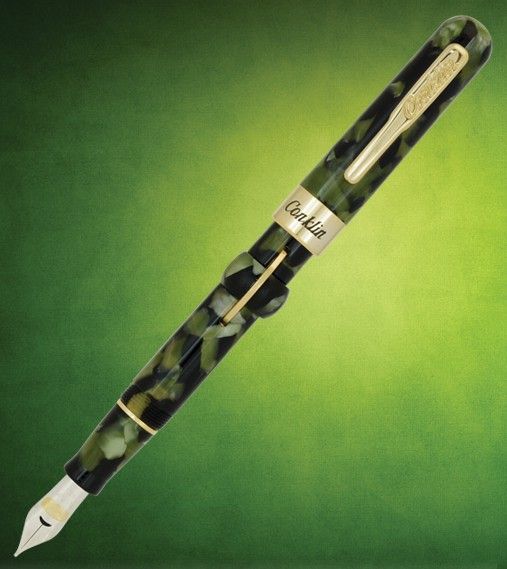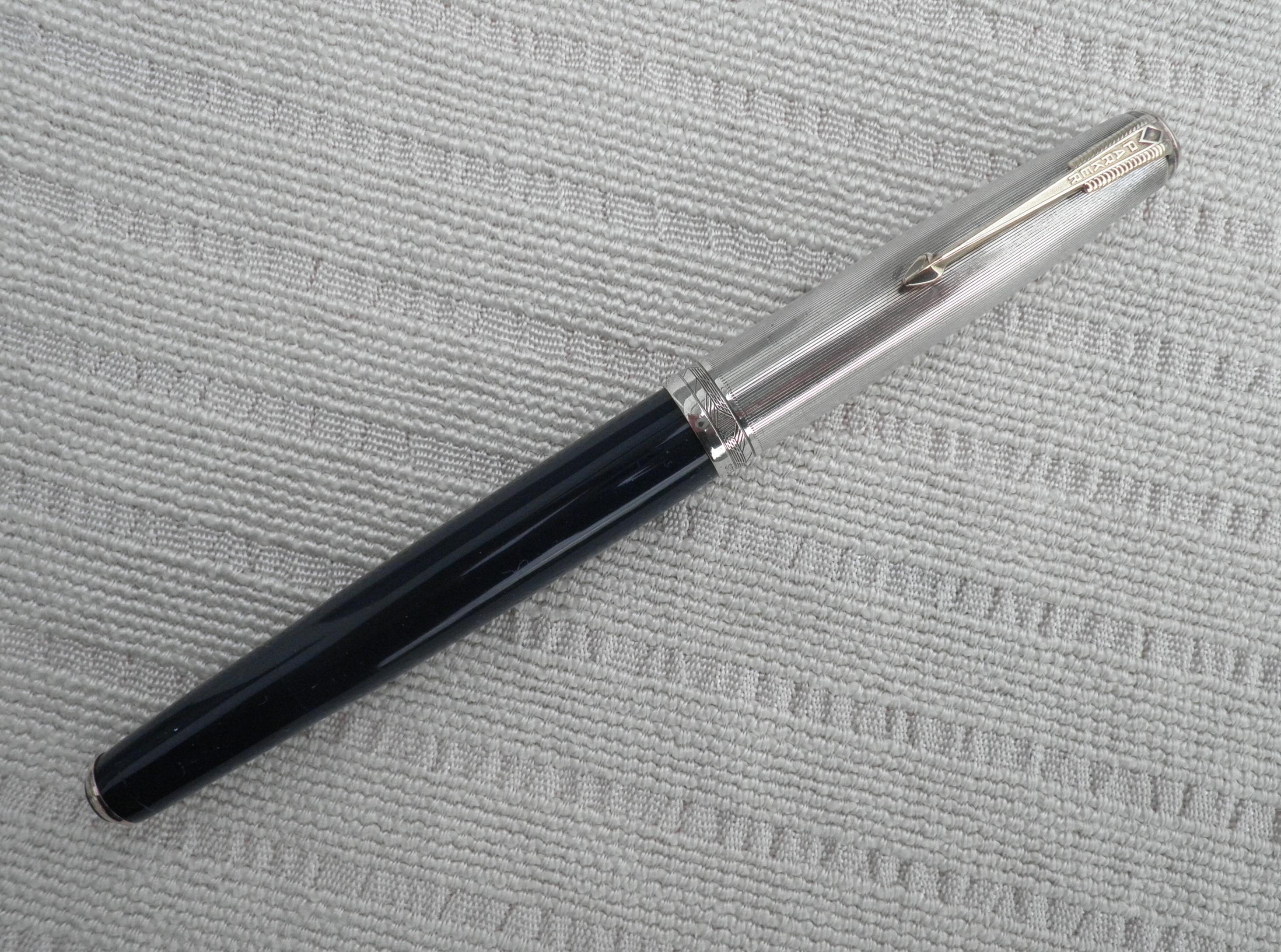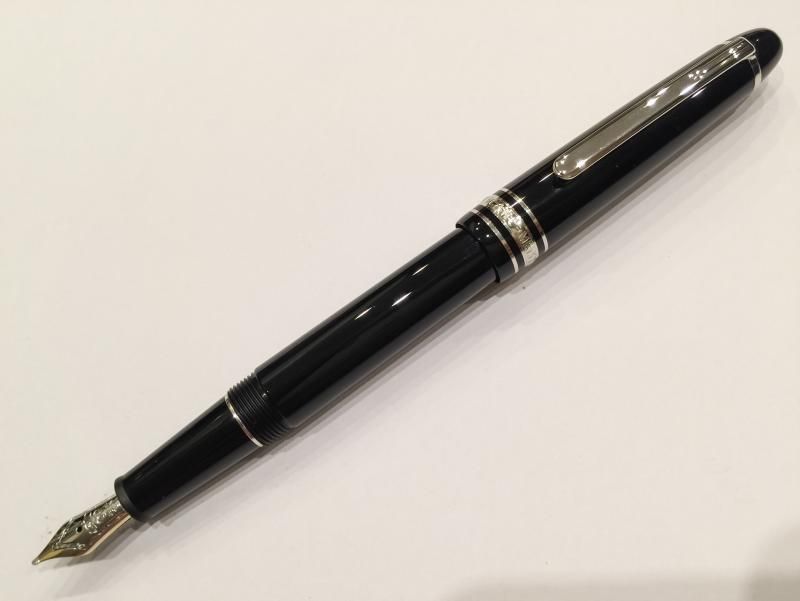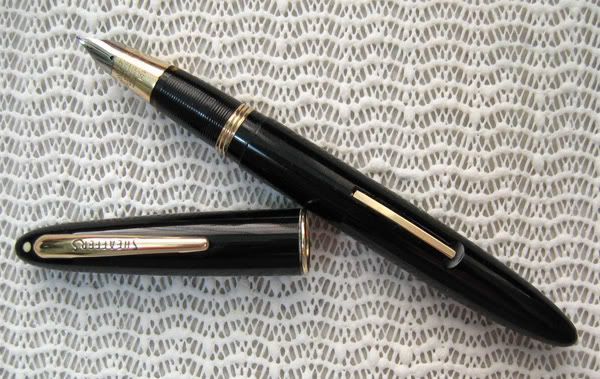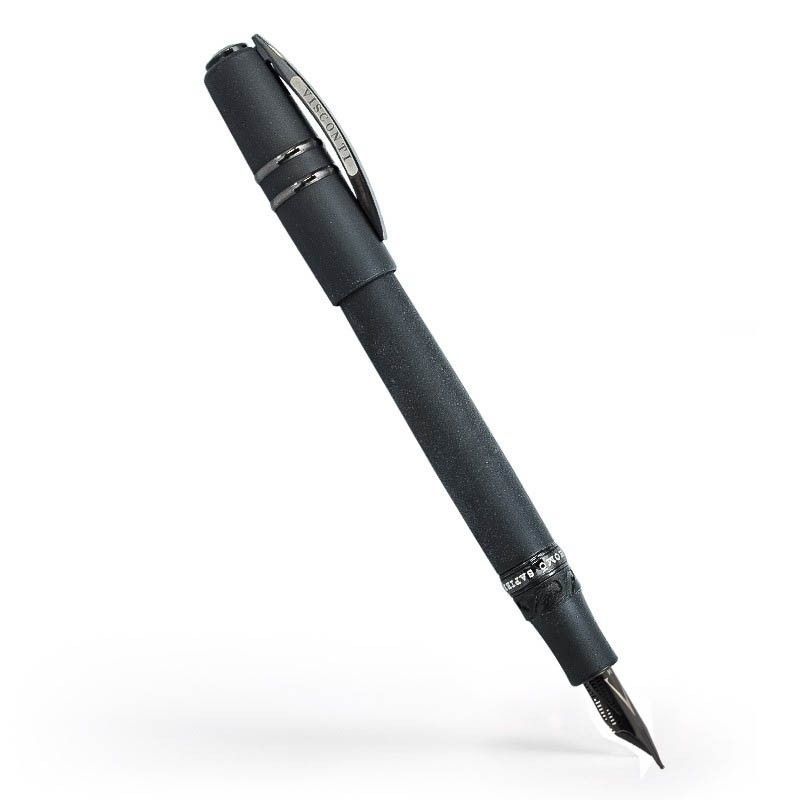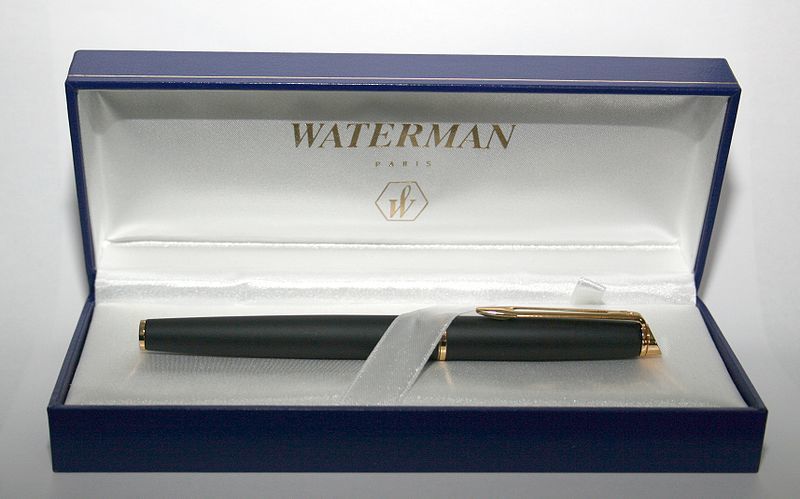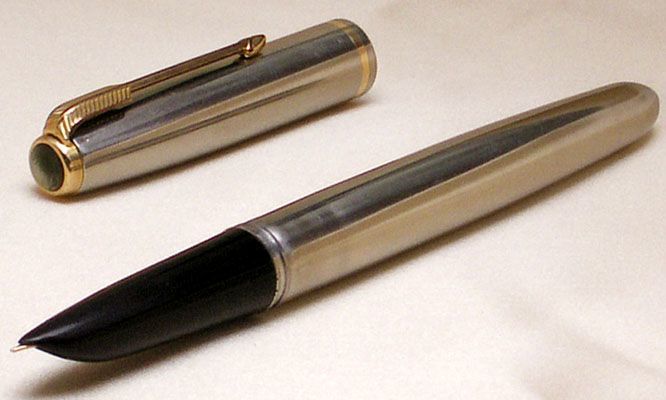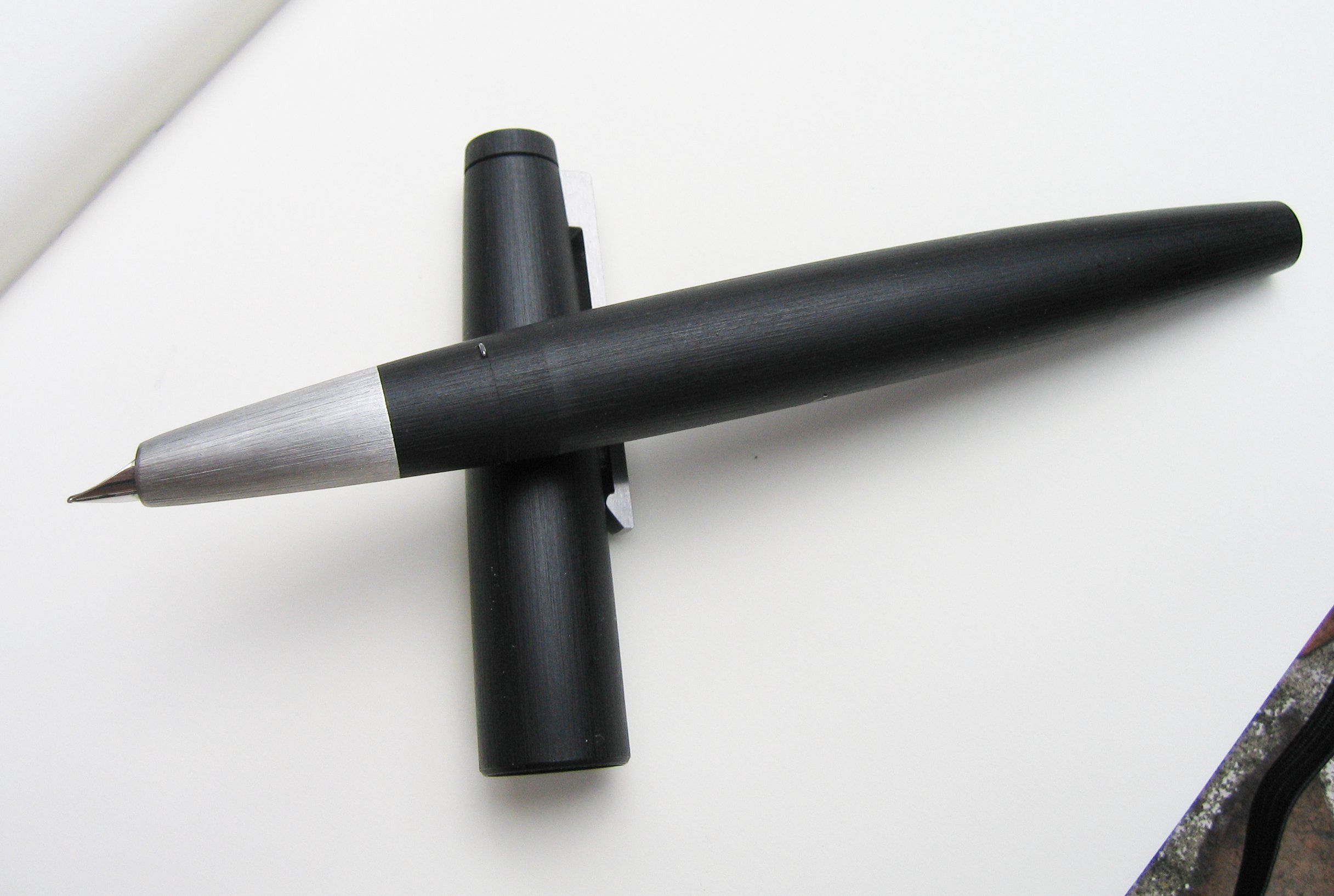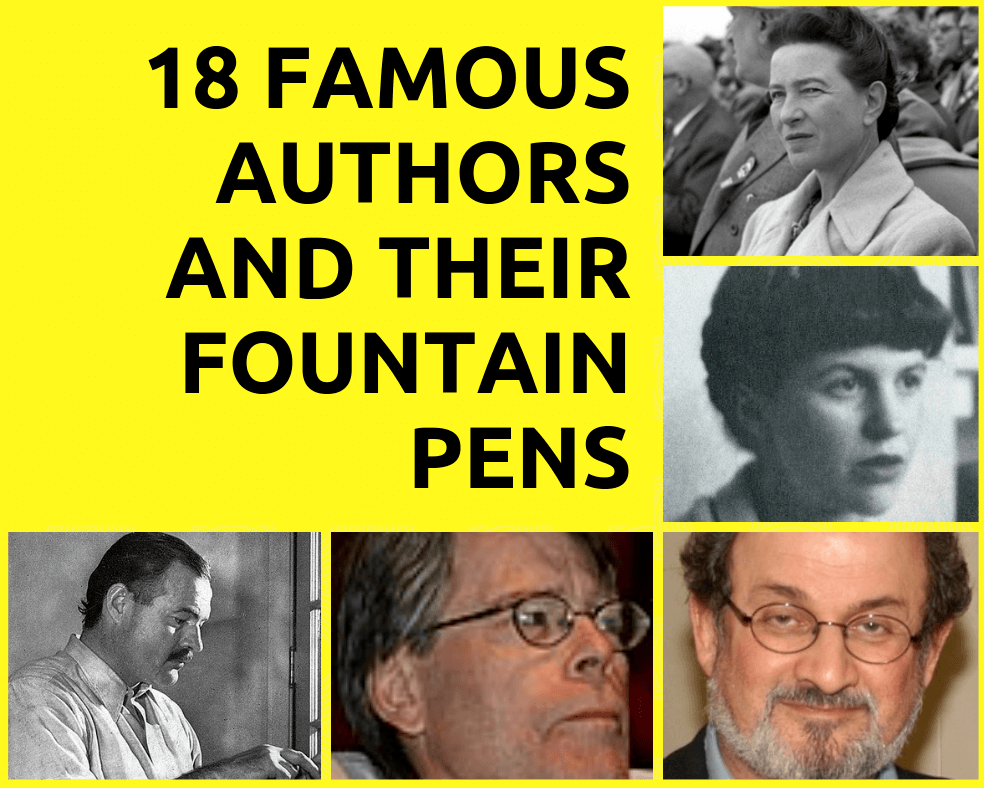
18 Famous Authors and Their Fountain Pens
There may be a simple secret to writing the next bestseller. (And it’s not purchasing the newest computer or downloading the latest app.) To write a great novel, you’ll need to go with a more time-honored approach such as writing with a fountain pen.
Some of the greatest authors in our literary canon rely on a trusty fountain pen to record their numinous imaginings. From Mark Twain to Christopher Paolini, the most venerated authors of the past 200 years each have a different fountain pen recommendation. Read on to discover which famous authors champion the analog writing process. Find out which writing instruments grace their desks to help compose that compelling page-turner!
1. Mark Twain – Conklin Crescent Filler
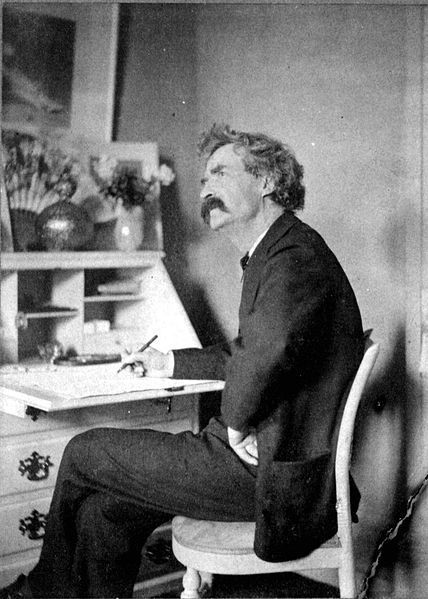
Source: Public Domain
Mark Twain’s influence on the American literary canon cannot be understated–he appears on nearly every high school English syllabus in the United States. He is best remembered for being an abolitionist and early critic of institutionalized racism. By authoring his magnum opus, The Adventures of Huckleberry Finn, he forever changed the way Americans viewed slavery. Huckleberry Finn was hugely controversial and considered one of the most austere cases of censorship in literature. It often topped the list as one of the most banned books in the American School system. However, what is largely unknown about Twain is that he was also a prominent influence in the fountain pen industry. Twain, the earliest literary luminary on our list, helped put an end to the days of the eyedropper filling method by fiercely promoting the newly invented Conklin Crescent Filler.
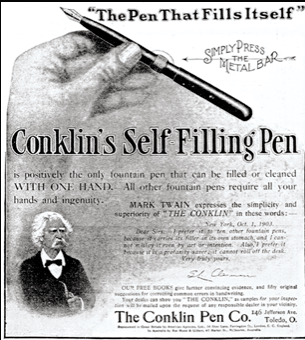
Source: fountainpennetwork.com
Twain’s interest in science and technology sparked a relationship with the Conklin fountain pen company back in the early 1900s. Until the early 20th century, nearly all fountain pens were filled with an eyedropper–a messy, time-consuming process. Roy Conklin set out to change the game by starting the Self-Filling Fountain Pen Company in 1898. In 1901, he changed the name of the company to Conklin Pen Manufacturing Co. and finally patented the Conklin Crescent Filler Pen two years later. Twain was eager to support the juncture and quickly became a spokesperson for the company.
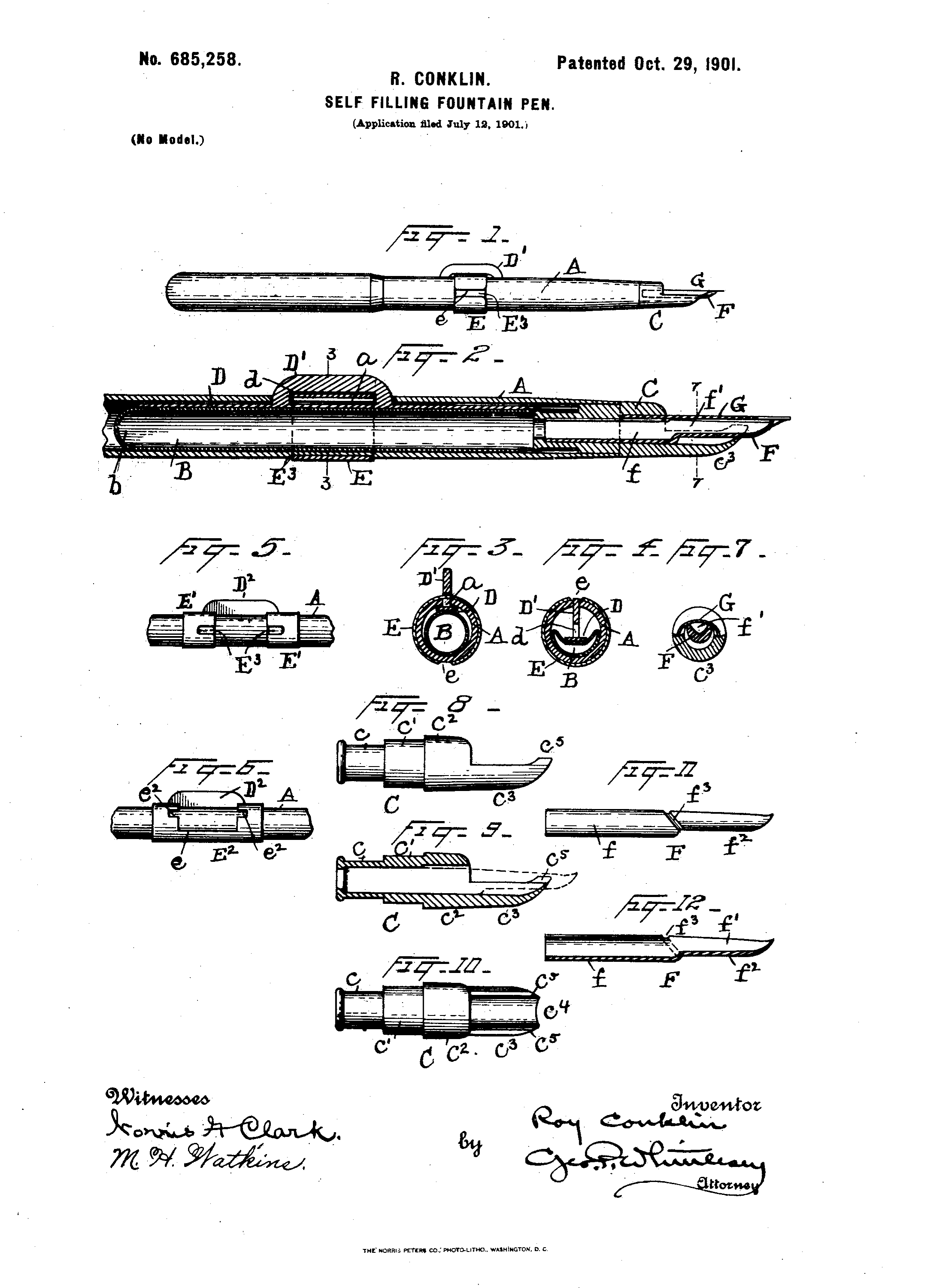
Roy Conklin’s patent for a self-filling fountain pen. Source: patents.google.com
What made the Conklin Crescent Filler unique at the time of its release was the internal filling mechanism. The pen’s barrel contained an embedded metal crescent. When this mechanism was depressed, it squeezed a rubber sac. This action created a vacuum, allowing ink to be drawn in through the nib. Once the crescent was released, the ink then moved to the reservoir sac ultimately filling the fountain pen. In a letter of endorsement later used in ad copy, Twain wrote: “I prefer it to ten other fountain pens, because it carries its filler in its own stomach, and I cannot mislay even by art or intention. Also, I prefer it because it is a profanity saver; it cannot roll off the desk.” Although the Crescent Filler wasn’t available when Twain was penning The Adventures of Huckleberry Finn, a profanity producing eyedropper fountain pen probably filled the pages behind the beloved story of Jim and Huck.
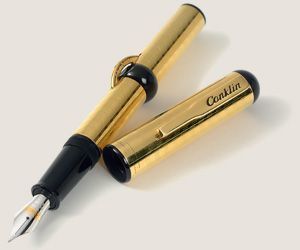
The Mark Twain Limited Edition Crescent Filler fountain pen. Source: conklinpens.com
Fun FactOf course, Mark Twain was the pen name for Samuel Langhorn Clemens. His pseudonym was inspired by a Mississippi River term “mark twain” which referred to a second mark on the line that measured depth, indicating two fathoms, or 12 feet, the minimum safe depth for riverboat travel.
Conklin Fountain Pens
The Mark Twain Crescent Filler fountain pen in Vintage Green with gold trim. Source: conklinpens.com
To this day, Conklin sells a line of Mark Twain fountain pens created in tribute to our most celebrated American humorist. Keeping up with the times, this collection includes a cartridge-converter fountain pen. If you prefer Twain’s favorite filling method, though, Conklin also sells a limited edition Mark Twain Conklin Crescent Filler. The Crescent Filler comes in a variety of colors, but it’s the vintage green model that reminds us of Huck sailing through the thick forests that line the Mississippi. As an amateur scientist, Twain probably would have preferred the clear acrylic demonstrator model, as it would have allowed him to see the internal workings of the pen.
2. Sir Arthur Conan Doyle – Parker Duofold
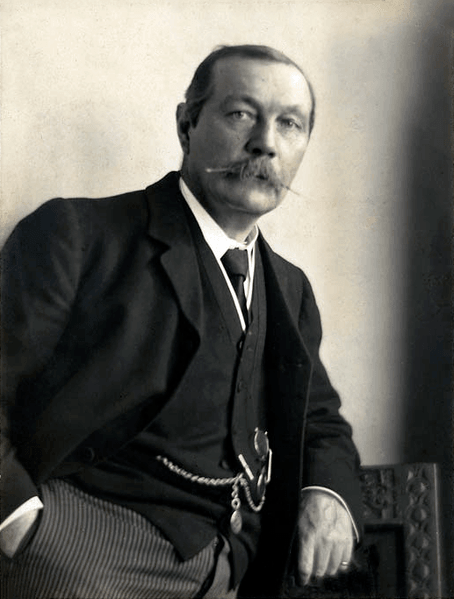
Source: Public domain
There’s no mystery surrounding what instrument Sir Arthur Conan Doyle used to create his famous Sherlock Holmes stories. (No, it’s not a magnifying glass.) Doyle penned four canonized Sherlock Holmes novels and 56 short stories during his lifetime. His expert weaving of tacit clues and red herrings throughout his plots earned him a dedicated worldwide audience which spans over a century. Since its creation in the 1890s, the Sherlock Holmes series has been adapted into countless movies and TV episodes. Doyle continued to write through the turn of the century, when the fountain pen industry began to boom. It isn’t shocking that he became a faithful patron.
Fun FactDoyle played on the same cricket team as Peter Pan author J.M. Barrie.
Parker Duofold fountain pen
The regal Parker Duofold Prestige Source: parkerpen.com
Doyle’s preferred writing instrument was a Parker Duofold fountain pen. The Parker Pen Company lauds the Duofold as the “reference in fountain pens.” The Duofold is one of Parker’s original models created in the early 1920s. Much like Michelangelo shaped David out of one block of marble, Parker Duofolds are molded out of a single solid block of acrylic. Twenty other high-quality components complete the pen’s detail. Since its origination, Parker has released an abundance of new Duofold editions. The most recent is the Parker Duofold Prestige, which is a modern take on a classic design. Obviously, the Parker Duofold family of pens remains widely respected to this day.
3. H. P. Lovecraft – Waterman
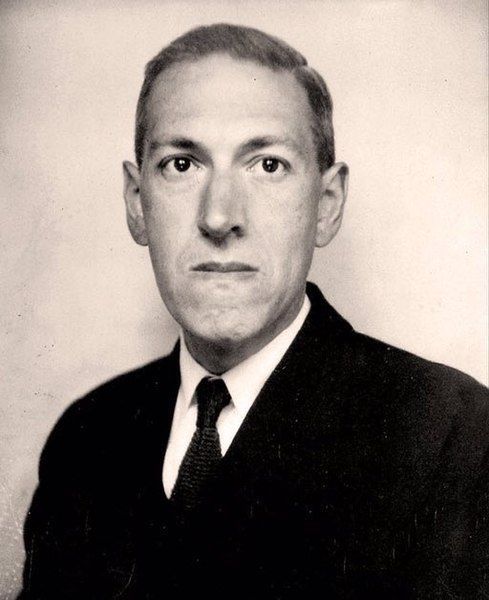
Source: Public domain
Beloved horror and weird fiction writer Howard Phillips Lovecraft succumbed to one of the worst fates a writer can endure: never being credited for his genius during his lifetime. None of his books were published while he was alive, and because of this Lovecraft died impoverished. His stories and correspondence were scattered across old issues of pulp magazines, destined to be forgotten. Luckily, a few of his friends stepped in to preserve the writer’s collectanea. After Lovecraft passed away, his friends August Derleth and Donald Wandrei formed the publishing firm Arkham House, named after Lovecraft’s fictional New England city and later referenced in Bob Kane’s Batman comic book series. Their express intent was to gather and publish the author’s work releasing them as completed books. Due to their efforts, the works of H. P. Lovecraft are now widely available in various formats and have been translated into over a dozen languages.
Fun FactLovecraft’s original dream was to be an astronomer. Considering he never finished high school, he didn’t pursue this goal.
Waterman Fountain Pens
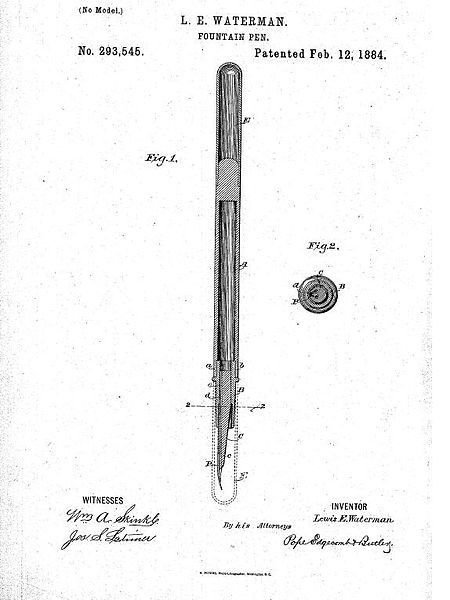
The patent for Waterman’s fountain pen from 1884. Source: Public domain
Xenophobic, reclusive, and a self-proclaimed Luddite, Lovecraft may have embraced fountain pens because they signify an analogue past that was quickly being superseded by a mechanistic future. According to his extensive correspondence, Lovecraft enjoyed the careful selection of his fountain pens. In a 1926 letter to his aunt, he wrote about his experience purchasing a pen: “I did not escape from the emporium till a $6.25 Waterman reposed in my pocket — a modern self-filler corresponding to the ancient $6.00 type which I bought in 1906.” A biographer of Lovecraft noted that he was incredibly particular about the fountain pens he used: “He used one pen, chosen with the most painstaking care, until it wore out…It had to have just the right kind of ink flow, molding itself to his hand in such a way…It also had to be a black Waterman; a pen of another color or make would have been unthinkable.” While he never stated which Waterman he preferred, it may have been the Waterman Perspective, of course, filled with black ink to match his tenebrous demeanor.
4. Ernest Hemingway – Montegrappa
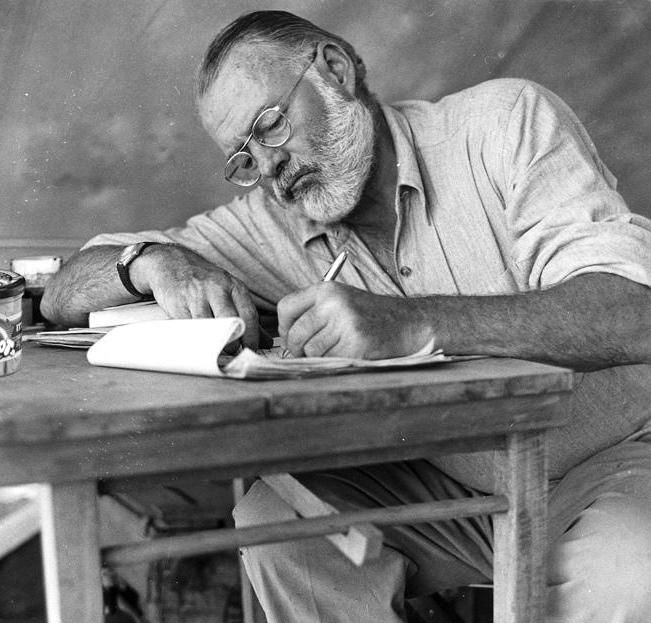
Source: fountainpennetwork.com
Before Ernest Hemingway became the “Papa” of the American literary world or won the Nobel Prize in Literature, he was a brazen young soldier trekking through Italy during WWI with a rather strange accessory in his pocket. A budding journalist at the time, Hemingway is fabled to have carried his ELMO fountain pen throughout the Great War, which inspired one of his most famous novels A Farewell to Arms. He selected this instrument because the company’s factory was located in Bassano del Grappa, very close to where Hemingway was stationed during the war. While ELMO pens may not seem familiar to even the most savvy of fountain pen lovers, they are better known by their current name, Montegrappa.
Fun FactHemingway worked closely with the KGB in World War II to spy on the Nazis. Although accused of war crimes in Geneva after the war ended, he was not convicted.
Waterman Fountain Pens
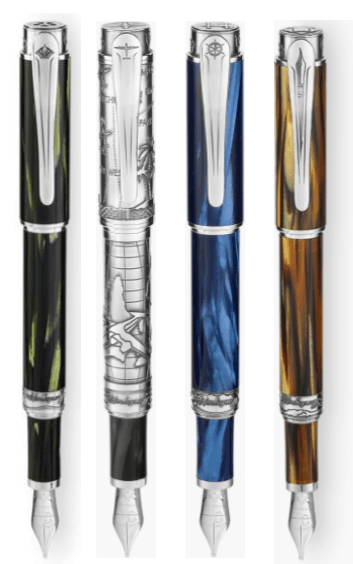
From left to right: Ernest Hemingway Soldier, Ernest Hemingway Traveller, Ernest Hemingway Fisherman, and Ernest Hemingway The Writer. Source: montegrappa.com
Of course, Montegrappa commissioned a collection of pens to honor their most esteemed literary subscriber. When designing these pens, the company sought to reflect four of the most notable chapters of Hemingway’s life: fighting in WWI, traveling, fishing, and, of course, writing. The Ernest Hemingway Soldier pen is made of bamboo black celluloid with precious metal trimmings. The pen’s details reflect Hemingway’s time fighting in Italy, including the emblem of the Red Cross Ambulance. The sterling silver Ernest Hemingway Traveller version is engraved with images from the author’s favorite places to visit, including Paris, Spain, and the Florida Keys. The marbled blue celluloid barrel of the Ernest Hemingway Fisherman model is trimmed with either silver or gold and imprinted with a marlin, one of the author’s favorite fish to catch. Finally, the Ernest Hemingway The Writer pen is made of turtle brown celluloid and features a typewriter with either sterling silver or 18k gold trimmings. Whichever Hemingway pen you choose, you can be certain that Montegrappa’s attention to detail in designing this collection is a reflection of this literary powerhouse’s spirit and ingenuity.
5. Graham Greene – Parker Duofold
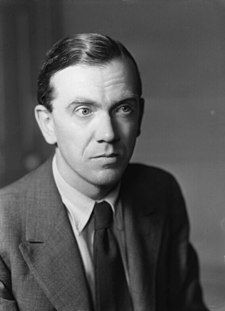
Source: Public domain
Famed author Graham Greene and popular silent film actor Charlie Chaplin could have started their own fountain pen fan club. When the two friends spent time together on the banks of a lake in Switzerland, we can surmise that at least one conversation centered around their favorite fountain pens. Greene’s enthusiasm for the writing instrument is demonstrated best in his own words: “My two fingers on a typewriter have never connected with my brain. My hand on a pen does. A fountain pen, of course. Ball-point pens are only good for filling out forms on a plane.” Greene has written a number of novels, including Brighton Rock and The Power and the Glory. He is usually categorized as a Roman Catholic novelist, but his works are respected by both religious and non-religious readers.
Fun FactTo make ends meet while writing his novels, Greene would also write screenplays and film reviews.
Parker Duofold Fountain Pen
The pronounced Parker Duofold Centennial. Source: fountainpennetwork.com
The slimmer Parker Duofold International. Source: parkerpen.com
Like fellow British novelist Sir Arthur Conan Doyle, Greene used a Parker Duofold fountain pen to draft some of his greatest works. Parker Duofolds have stood the test of time and continue to be widely used by fountain pen enthusiasts today. The Duofold has long been known for its thick girth, and the Centennial version of the pen reflects its classic size. However, if you are looking for a slimmer pen, the Duofold International is the better choice. Both pens hold the same size converter and cartridge, so choosing one over the other does not sacrifice functionality.
6. Simone de Beauvoir – Sheaffer Snorkel and Esterbrook J
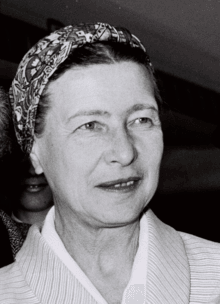
Source: Moshe Milner, Simone de Beauvoir2, CC BY-SA 3.0
Simone de Beauvoir can be described in many ways: novelist, academic, intellectual, mathematician, philosopher, feminist–the list continues from there. For this modern-day Renaissance woman, a fountain pen was the perfect tool to record her vast intellectual repertoire.
De Beauvoir spent much of her life writing. Her most famous novels include The Mandarins, She Came to Stay, and The Blood of Others. However, she is best known for the impact she had on the world at large through her philosophical material. These include The Ethics of Ambiguity and The Second Sex. Outside of her writing, de Beauvoir is known for having enjoyed a life-long romantic relationship with another famous philosopher, the existentialist Jean-Paul Sartre, a fellow classmate at La Sorbonne. Imagine the conversations around their dinner table! Marriage for these two was not possible because de Beauvoir had no dowry which at that time in history meant she was “no longer was a viable commodity for a suitor.” This outdated rule surely chafed her feminist leanings. Their unofficial union didn’t seem to trouble her too much as it allowed her to explore trysts with a rotating collection of paramours while still maintaining her relationship with Sartre. Just as de Beauvoir refused to be confined to one field of study or a single romantic relationship, she also denied allegiance to any particular fountain pen company.
Fun FactFor much of her childhood, de Beauvoir dreamed of becoming a nun.
Sheaffer Snorkel Fountain Pen
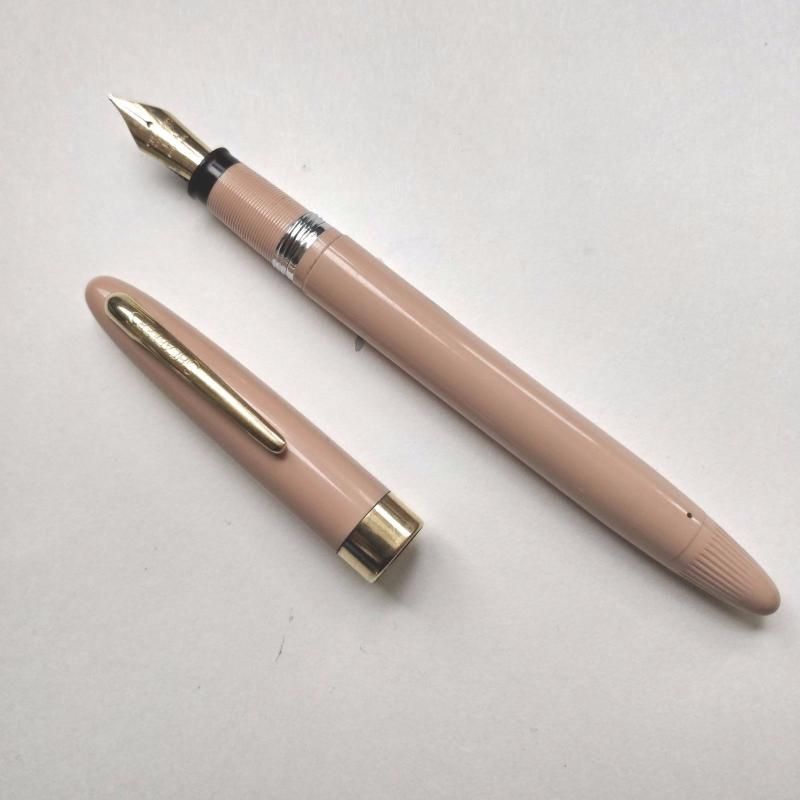
A Sheaffer Snorkel fountain pen. Source: fountainpennetwork.com
If you enjoy an afternoon dip in the ocean, this member of de Beauvoir’s collection would have been the pen for you! The Sheaffer Snorkel was known for having the most complex filling process ever created. It was designed to prevent the user from having to submerge the pen into the ink bottle, thereby avoiding a mess. Snorkel pens included a long, skinny tube that extended from behind the nib once the user needed to fill the pen. This “snorkel” feature is used to draw ink into the pen like a straw. This process prevented the nib or barrel from touching the ink, transforming the ink-filling process in a seemingly convoluted and overly-complex way. Unfortunately, elaborate mechanical designs don’t often last and the pen was discontinued. However, de Beauvoir enjoyed the Snorkel enough to use it daily. If you are looking for one of these unique pens, your best bet is a resale or auction site.
Esterbrook J Fountain Pen
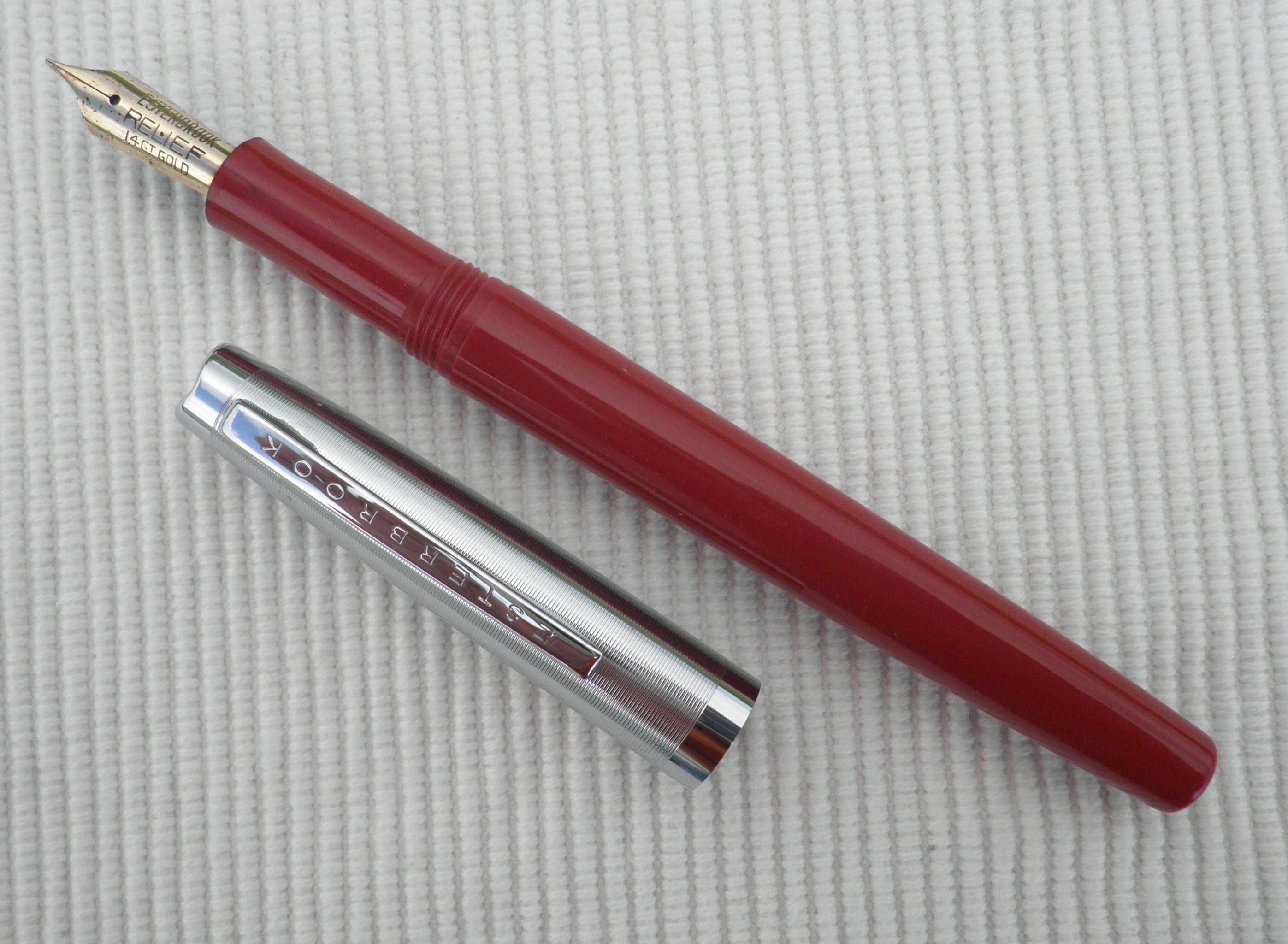
The Esterbrook J fountain pen. Source: fountainpennetwork.com
As a woman rooted in the bourgeois class, it’s no surprise that de Beauvoir has also been photographed using a middle-class pen like the Esterbrook J. The J series was one of Esterbrook’s most popular pens, produced during the 1950s. Featuring a patented system of interchangeable nibs, the user could effortlessly adjust the thickness of their line. Js were more affordable for the everyday user due to their strong, plastic source material. A starving artist like de Beauvoir would definitely appreciate the pen’s cost effective price. The original Esterbrook J is no longer produced, but the company has recently created a new line of Js to honor their most popular model.
7. Dylan Thomas – Parker 51
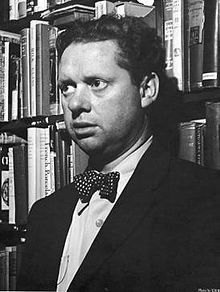
Source: allposters.uk.com
One of the most prolific Welsh poets (and fountain pen users) of all time didn’t even finish high school. Dylan Thomas ended his educational career at 16 due to mediocre marks. He then pursued journalism for a few years before writing his breakout poem, “Light breaks where no sun shines.” Fame does not always equate to income, though. As such, Thomas spent much of his time touring and doing BBC radio broadcasts to make ends meet. His popularity has only grown since his premature death at age 39. One of his most famous poems, “Do not go gentle into that good night”, is still widely read and quoted today.
Fun FactThomas apparently plagiarized one of his earliest published poems, “His Requiem”. The literary theft wasn’t discovered for almost 40 years.
Parker 51 Fountain Pen
The Parker 51, a favorite among fountain pen users, particularly Dylan Thomas. Source: fountainpennetwork.com
Although he would not have known it, Thomas used the same fountain pen as British A-listers and royalty. Emma Watson and Queen Elizabeth II both famously use this instrument. The Parker 51 was released in 1941, only 12 years before Thomas’ death. Despite the short amount of time available for Thomas to use the pen, the poet was photographed using the pen several times. Thomas also would have loved “Quink”, Parker’s line of fast drying ink. This allowed a serious writer like him to jot down his thoughts quickly with a quality instrument and no fear of smudging.
While the Parker 51 is no longer officially in production, it is still available for purchase.
8. Harper Lee and her Fountain Pens
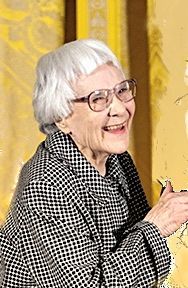
If it weren’t for fountain pens, we may never have been able to read Atticus Finch’s famous words: “You’ll never really understand a person until you climb into his skin and walk around in it.” To Kill a Mockingbird author Harper Lee is one of few writers to gain immense acclaim for only having published one novel for the majority of her career (and live off of its success). She refused to release anything for many years after her first book. However, the To Kill A Mockingbird prequel, Go Set a Watchman, was published just before she died. Lee’s health had drastically deteriorated at this point, so the novel’s release aroused one of the biggest literary controversies of the 21st century. The chain of events went something like this: Her sister Alice, who was her protector for many years, had recently died. Lee’s new protector, Tonja Carter, suddenly approached HarperCollins with the draft of Watchman, claiming to have found it just before Alice’s death. Many Lee fans viewed the release of Watchman as a money-grab for Carter, and something that Lee in sound mind and health would never authorize. Nevertheless, the book still sold over a million copies in its first week.
Whether Lee wanted the novel printed or not, it is certain she used (or at least greatly respected) fountain pens. The brand isn’t specified, but she explicitly placed one in Atticus Finch’s coat pocket during the famous courtroom scene in To Kill a Mockingbird. While fellow author and close friend Truman Capote was vocal about his practice of using a pencil and legal pad to write, Lee was unusually secretive about both her personal life and writing process. But the fact that she mentions this seemingly small detail in the novel is a good indication that she used a fountain pen as well. Fountain pens are clearly the perfect instrument for building credibility during character development! Just see our post on Fountain Pens in Film and TV!
Fun FactDespite earning millions of dollars from To Kill a Mockingbird royalties over her lifetime, Lee lead a frugal life–she lived without a computer, cell phone, or even air conditioning in her hot, humid Alabama home from 1961 to 2016.
9. Anne Frank – Montblanc Meisterstück
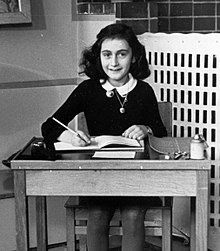
Anne Frank recorded one of the darkest eras in history with a fountain pen and her trusted diary, Kitty. Of course, Kitty became what is today cherished as Anne Frank’s Diary of a Young Girl. The chronicle of Anne’s experience hiding in the Annex has has been published into more than 60 languages and earned her a place among the greatest writers of all time. While her fountain pen did not survive WWII, the words she penned with it live on, still touching the hearts of millions of people around the world today.
Fun FactAnne Frank wrote short stories and collected favorite sentences by famous authors within the pages of her journal.
Montblanc Fountain Pens
A Montblanc Meisterstück Platinum 145 fountain pen. Source: fountainpennetwork.com
It is widely speculated that Anne used a Montblanc pen to compose her diary–a pen that is rumored to have been destroyed in a fire. She received the instrument as a gift for her ninth birthday. Can you imagine sending your 4th grader to school with a $200 pen in their backpack? While the exact model that she used has not been confirmed, it was likely a Meisterstück, one of the company’s most popular models of the time period. Montblanc releases a limited edition Meisterstück to honor famous authors each year, so 21st century patrons are anxiously waiting for the company to create an instrument in Anne Frank’s honor.
10. Sylvia Plath – Sheaffer
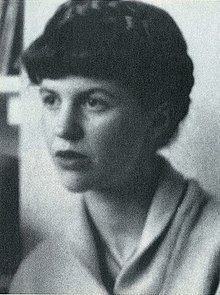
Notable author Sylvia Plath described her most famous novel, The Bell Jar, as “an autobiographical apprentice work which I had to write in order to free myself from the past.” Like so many novelists, writing proved to be a form of escapism blended with therapy for Plath. Unfortunately, she lost her battle with depression in 1963, and some of her works were withheld from publication until 2013. Plath and her husband, Ted Hughes, were officially separated at the time of her death, but not divorced, allowing him to legally inherit her estate. In order to protect himself and their family, Hughes chose to burn Plath’s last journal rather than release it to the public. He has also been accused of misplacing another journal and unfinished novel. Luckily for Plath’s fans, these surviving unpublished works were located and lawfully released 50 years after her death. While Hughes did his best to prevent the public from seeing many of his wife’s later works, he did reveal her love for Sheaffer fountain pens in his own book, Birthday Letters.
Fun FactPlath and Hughes chose to be married on June 16th to honor Bloomsday, the day when James Joyce’s Ulysses takes place.
Sheaffer Fountain Pens
The distinct Sheaffer lever filler fountain pen. Courtesy of Artaddict
Sheaffer’s claim to fame in the fountain pen industry is designing unique filling systems, like Simone de Beauvoir’s Snorkel. Plath most likely used one of their early lever filler pens. Since her death, the company has changed hands several times. Bic acquired Sheaffer in 1997 and then sold the company to Cross in 2015. Finally, Transom Capital Group announced its acquisition of the assets of A.T. Cross Company (“Cross”) in 2017. While lever-fill Sheaffers are no longer produced, you can purchase a new Cross-Sheaffer pen here.
11. Peter Straub – Visconti
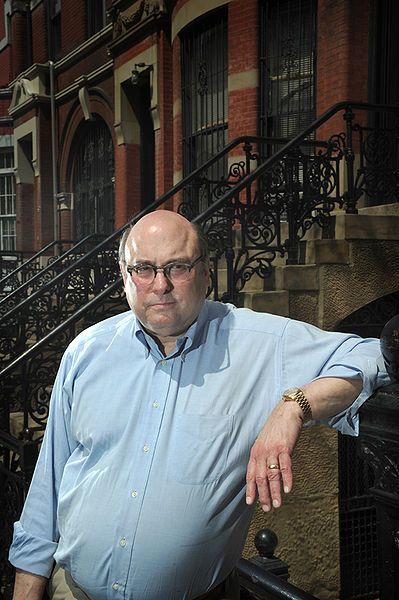
Source: KyleCassidy (identity confirmed), Peter Straub, CC BY-SA 3.0
Can you imagine collaborating on a project as significant as a novel with another author over the phone? Before the days of Google’s G Suite, this was the only option for Peter Straub, who co-wrote The Talisman with Stephen King in 1983. Although the two authors took turns typing as they spoke, Straub changed his approach for later works. He now prefers to write his first drafts by hand. In an interview with Bookbanter, he claims writing with pen and paper “feels more immediate… more physical and grounded.” Straub credits Visconti fountain pens in the acknowledgments for his 2003 Bram Stoker Award-winning novel Lost Boy, Lost Girl. This prize-winning work, which helped Straub’s fame to ignite, may have originated with a writing device crafted from molten lava.
Fun FactStraub has won an impressive eight Stokers in his career so far.
Visconti Fountain Pens
The alluring Visconti Homo Sapiens Dark Age fountain pen. Source: visconti.it
If you want your writing to explode off of the page, the Visconti Homo Sapiens pen is the instrument for you! The Homo Sapiens is infused with hardened volcanic lava from Mount Etna in Sicily, making it virtually unbreakable. When purchasing your own Homo Sapiens, you can select either bronze, steel, or black trim. While Straub hasn’t confirmed which Visconti is his favorite, he says he prefers the brand because their products are “Italian and elegant.” This, of course, adds to the aesthetic of analogue writing.
12. Salman Rushdie – Vintage Fountain Pens
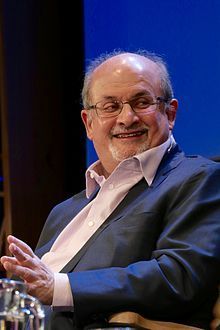
Source: Andrew Lih (User:Fuzheado), Hayfestival-2016-Salman-Rushdie-1-cu, CC BY-SA 3.0
One novel that British-Indian author Salman Rushdie wrote almost cost him his life. Rushdie’s controversial book The Satanic Verses loosely follows the life of Muhammad, the founder of Islam. This source material might seem like a bold commentary on Rushdie’s childhood growing up in a Muslim family. As such, some members of the Islamic community were outraged because of the way he portrays certain events from Muhammad’s life. It even elicited some death threats. Despite the dissension, today many Muslims venerate the novel as a brilliant piece of Islamic intellectualism. Unlike previously mentioned authors, the instrument behind these potent words was probably not a singular pen at all. Rushdie is more concerned with the vintage of the pen than its branding.
Vintage Fountain Pens
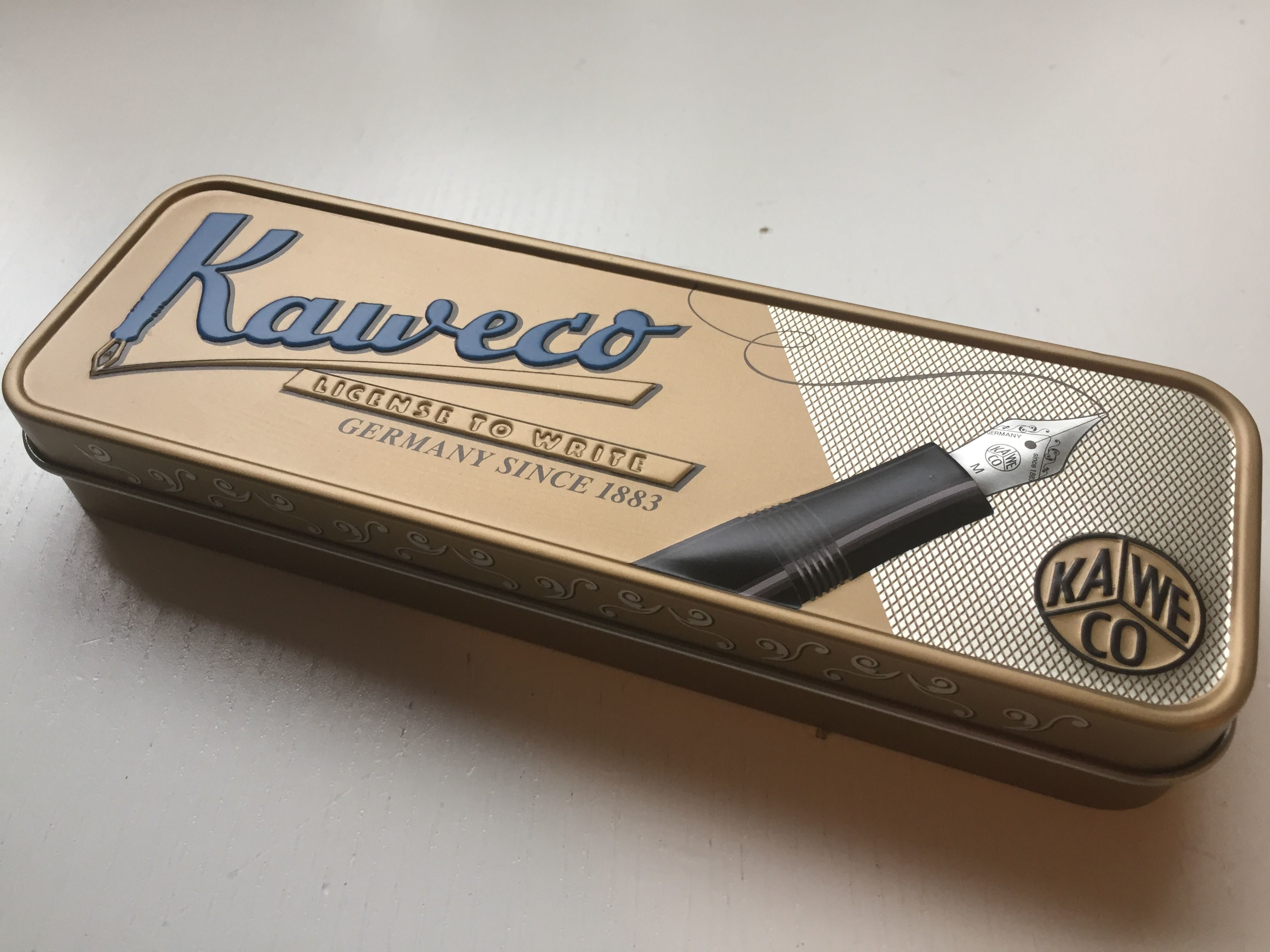
A vintage Kaweco fountain pen tin. Source: Scrively
Rushdie collects vintage fountain pens and uses them to draft his novels. He has also utilized antique writing instruments in more public settings. When Rushdie was inducted to the Royal Society of Literature in London, he signed his oath with a pen so vintage it was almost an artifact. At the time of Rushdie’s induction, new members could choose to use a dip pen that belonged to either Charles Dickens or Lord Byron. Rushdie chose Byron’s, although he says he could have just as easily selected Dickens’.
Fun FactCharles Dickens’ quill was retired from its Royal Society of Literature oath-signing duties in 2013, after Rushdie was inducted. It was replaced by T.S. Eliot’s fountain pen.
13. Stephen King – Waterman Hémisphere
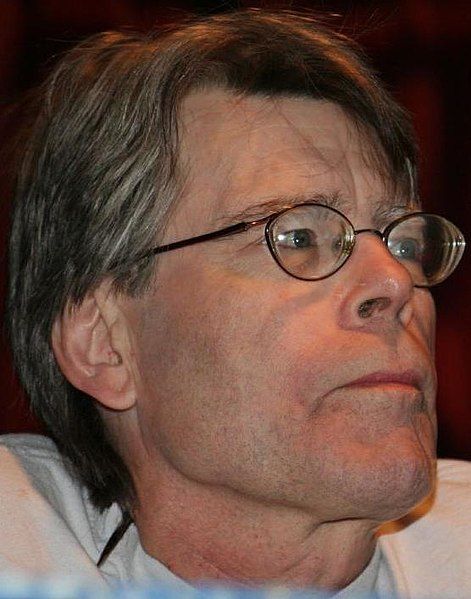
Source: Pinguino Kolb, Stephen King, Comicon, CC BY 2.0
There’s a good reason picking up a Waterman Hémisphere sends a chill down your spine. Best-selling horror novelist Stephen King has used this pen to create some of the most terrifying scenes in his 95+ novels, including It and Carrie. He has also bestowed his writing wisdom upon junior authors in his nonfiction book On Writing: A Memoir of the Craft. King advises young novelists to write using non-digital methods with few distractions. While he doesn’t exclusively draft novels in longhand, he believes it forces the writer to slow down and get physically involved with the writing process.
Fun FactStephen King threw the first draft of Carrie in the trash. His wife picked it out, offered her female perspective, and the book became his first bestseller. Talk about close calls!
Waterman Hémisphere Fountain Pen
Ready for presentation, the Waterman Hémisphere fountain pen. Source: Berniewilson at English Wikipedia., Waterman hemisphere inbox, CC BY 2.5
On a dark and stormy night, King drafted a portion of Dreamcatcher by candlelight with his Waterman Hémisphere fountain pen. In the back of the published book, he wrote: “One final note. This book was written with the world’s finest word processor, a Waterman cartridge fountain pen.” In fact, on Twitter in 2014, King tweeted that he “wore out four Watermans” writing the novel. The Hémisphere is one of Waterman’s less expensive models, explaining King’s willingness to burn through four in one project. Each Waterman pen is meticulously designed and reviewed to ensure superiority, making it perfect for a scrupulous wordsmith like King.
14. Haruki Murakami – Sailor and Parker

Source: wakarimasita of Flickr, HarukiMurakami, CC BY-SA 3.0
Celebrated Japanese author Haruki Murakami has a particularly close relationship with fountain pens. At the beginning of his award-laden career, Murakami purchased his first fountain pen for $5. Since gaining popularity worldwide, the author has been able to afford more expensive instruments. He infuses this elegant taste into some of the personages in his novels as well. While characters in 1Q84 and The Wind Up Bird Chronicle use Montblanc pens, Murakami has never confirmed that he too owns a Montblanc. However, he has spoken about his earliest fountain pen purchase–an inexpensive Sailor.
Fun FactWhile Murakami is a trained English language translator, he doesn’t convert his own novels from Japanese to English. Instead, he leaves the translation of his own work to other trained professionals.
Sailor Fountain Pens
A Sailor 1911 Large Lefty Series fountain pen. Source: sailor.uk.com
In a 2008 New Yorker article (eventually published in his book What I Talk About when I Talk About Running) “The Running Novelist,” Murakami describes his beginnings as a writer: “When I thought about sitting down at my desk at home and starting to write, I realized that I didn’t even own a decent fountain pen. So I went to the Kinokuniya store in Shinjuku and bought a sheaf of manuscript paper and a five-dollar Sailor pen.” Established in 1911 by a Japanese engineer, Sailor was the first Japanese company to manufacture fountain pens. He named the company after the occupation of the British sailor that introduced him to the world of fountain pens. The stand-out feature on their pens is the nib, which is handcrafted by Nobuyoshi Nagahara–an expert nibmeister who has been designing them for over sixty years. Sailor pens are still made in Hiroshima and remain popular around the world. They continue to innovate the fountain pen industry, and even have a line of pens designed for the left-handed.
Parker Fountain Pens
The Parker Duofold Prestige in blue chevron. Source: parkerpen.com
Murakami has ties to another fountain pen company as well. In the mid-90s, he wrote advertorial fiction for the luxury brand Parker Pens. To promote the company, he published twenty-four flash fiction pieces under the serial title Murakami Asahidō (Murakami’s House of the Rising Sun) in the Japanese magazine Taiyō. While they were sponsored by Parker Pens, these stories were included in the index listing of the magazine like regular content. Remarkably, Murakami makes no mention of Parker’s products directly in text, instead allowing the reader to draw a positive impression of the company by associating it with a writer of high regard.
15. Jonathan Carroll – Parker 51
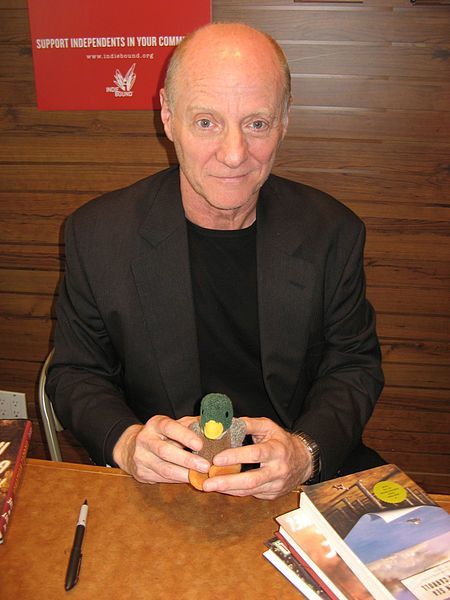
Source: 48states at English Wikipedia, Jonathan Carroll in SF, CC BY-SA 3.0
While the settings of Jonathan Carroll’s novels seem like normal, real-life places, his characters are often anything but typical. He is known to infuse surprises like talking dogs and supernatural events into otherwise realistic stories, creating an entirely different experience for his readers. This type of tale, reflected in Outside the Dog Museum, fits easily into the magical realism genre. Carroll is staunchly dedicated to crafting the first draft of these odd but enticing novels by hand. However, what makes him different from the previously mentioned authors is that he also handwrites his second and third drafts. Clearly, Carroll believes in the power of the pen!
Fun FactWhile Carroll is American by birth, he has lived in Austria since the 1970s.
Parker 51 Fountain Pens
Jonathan Carroll is a fan of the Parker 51 fountain pen. Source: fountainpennetwork.com
Carroll even selects a special notebook into which he copies the final drafts of his works with his preferred fountain pen, the venerable Parker 51. In an interview with Ryder Carroll (his son and the inventor of the Bullet Journal), Jonathan Carroll describes his writing process: “I begin by typing very quickly anything and everything that comes to mind as far as a plot line goes. Then I get out one of my beloved old Parker 51 fountain pens and write down what I have typed, editing while I go. Then I write it again, slowly, looking to see what I really want to keep or throw out. Finally, I copy the finished story into some really beautiful notebook which I have chosen for this specific novel or collection of stories.” Carroll emphasizes the importance of scribing with fountain pens to his creative process, stating that the physical act forces him to accurately measure the merit of each idea. Although Carroll writes primarily with the Parker 51, he also keeps the Montblanc fountain pen used to write part of his first novel, The Land of Laughs.
16. Neil Gaiman – Pilot Custom 823 and LAMY 2000
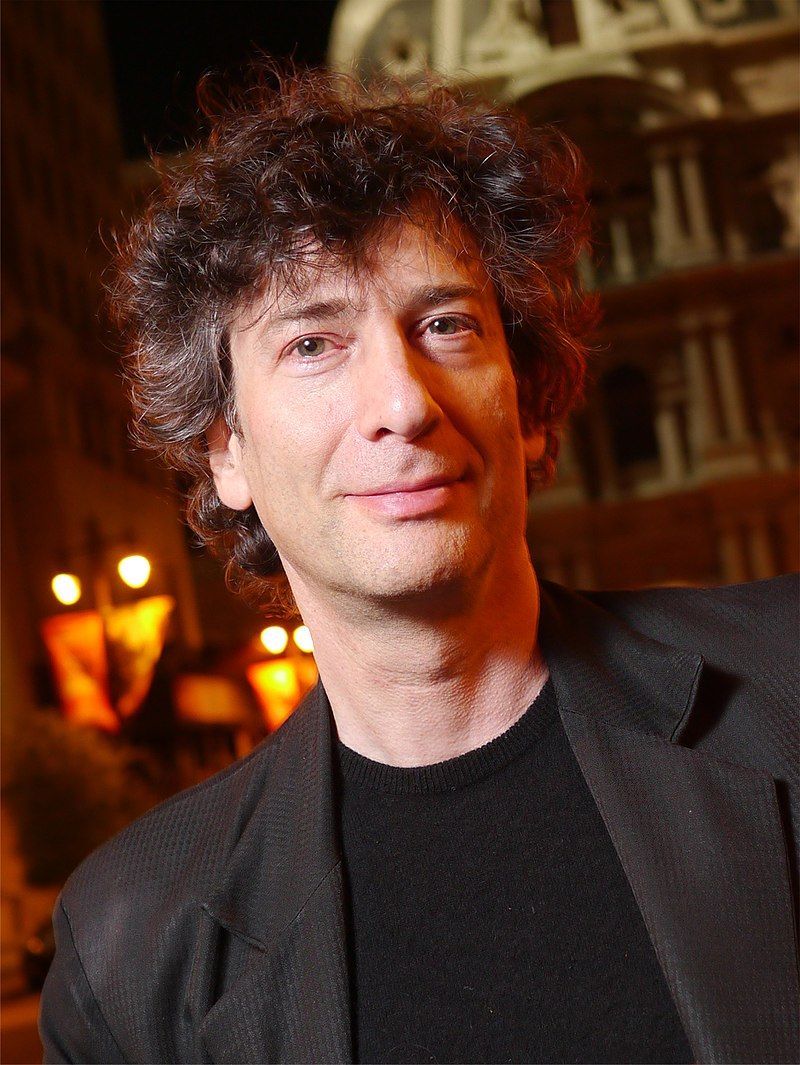
Source: Kyle Cassidy, Kyle-cassidy-neil-gaiman-April-2013, CC BY-SA 3.0
Not so long ago, in the not-so-far-away land of Porchester, England, Neil Gaiman began penning award-winning novels and comic books with his trusty fountain pen. Often drawing inspiration from ancient myths and legends, it’s no surprise that Gaiman prefers an anachronistic writing instrument from the days of yore. Changing his ink color daily to track progress, the first draft of each of his novels is in longhand. He advocates that all budding writers tackle their first draft in the same way. A speed demon with a ballpoint, Gaiman states that working with a fountain pen “slows me down just enough to keep my handwriting legible.” Just as Zeus entrusted heroes with individual mantles of glory in ancient myths, Gaiman assigns different pens for specific writing tasks. He is a self-proclaimed lover of many fountain pens, including Visconti, Delta Fluida, TWSI Diamond 540, and Lepine Indigo Classic. However, his absolute favorite pens can be whittled down to just two: one for book signing and one for novel writing.
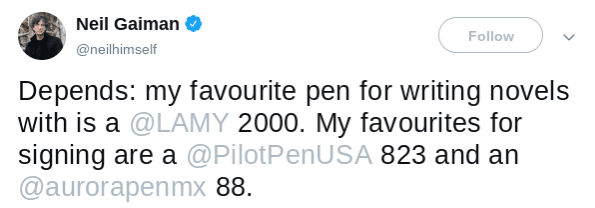
Neil Gaiman’s post on Twitter about his favorite fountain pens. Source: Author
Fun FactGaiman’s 2008 novel The Graveyard Book is the first to win both the Newbery and Carnegie medals–the most prestigious writing awards in the United States and the United Kingdom, respectively.
Pilot Custom 823
Displayed in brown, the well-respected Pilot Custom 823. Source: fountainpennetwork.com
If you meet Neil Gaiman in person, you’ll likely catch him using a Pilot Custom 823–his preferred pen for book signings. Its intelligent design reflects both aesthetic and practical purposes. The barrel is made of a gorgeous, translucent amber, stimulating to the eye. Satisfying a need for functionality, this posh demonstrator allows the user to easily see how much ink remains. The Pilot 823 is filled with an easy-to-use vacuum filler. Its roomy, 2.2 mL converter allows authors like Gaiman to write (or sign) for hours at a time. Once the converter runs dry, recharging this pen is a quick and fluid task.
LAMY 2000
The LAMY 2000, a sure favorite of fountain pen aficionados. Source: Glenn Strong
For longform writing, Gaiman prefers the LAMY 2000. The 2000 is perfect for the butterfingered user, or someone like Gaiman who writes for long stretches of time. A fiberglass and brushed stainless steel body offers a textured surface that makes it virtually drop-proof. Its clean and square lines are inspired by the Bauhaus movement, a school of design that championed minimalism. Another hallmark of the LAMY 2000 design is its hooded nib. Appearing to be a ballpoint at first glance, an extra-fine nib peeks out of the body of the pen. Gaiman uses the LAMY 2000 to draft many of his novels longhand, so you know he must be able to quickly change ink colors to enact his progress-checking process.
17. Joe Hill – Pilot Metropolitan
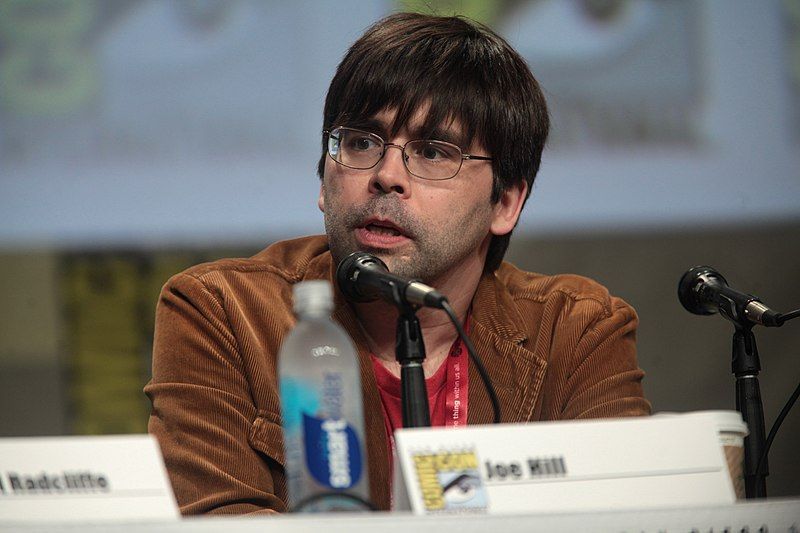
Source: Gage Skidmore from Peoria, AZ, United States of America, Joe Hill (14778218361), CC BY-SA 2.0
Joe Hill starts each writing day with a full cup of coffee and a full fountain pen. Author of four novels and a long-running comic book series, he’s got his writing process down to a science. In a blog post, Hill says that each day he writes “1,500 words, longhand, with a fountain pen, scribbling in a Leuchtturm1917 hardback notebook.”
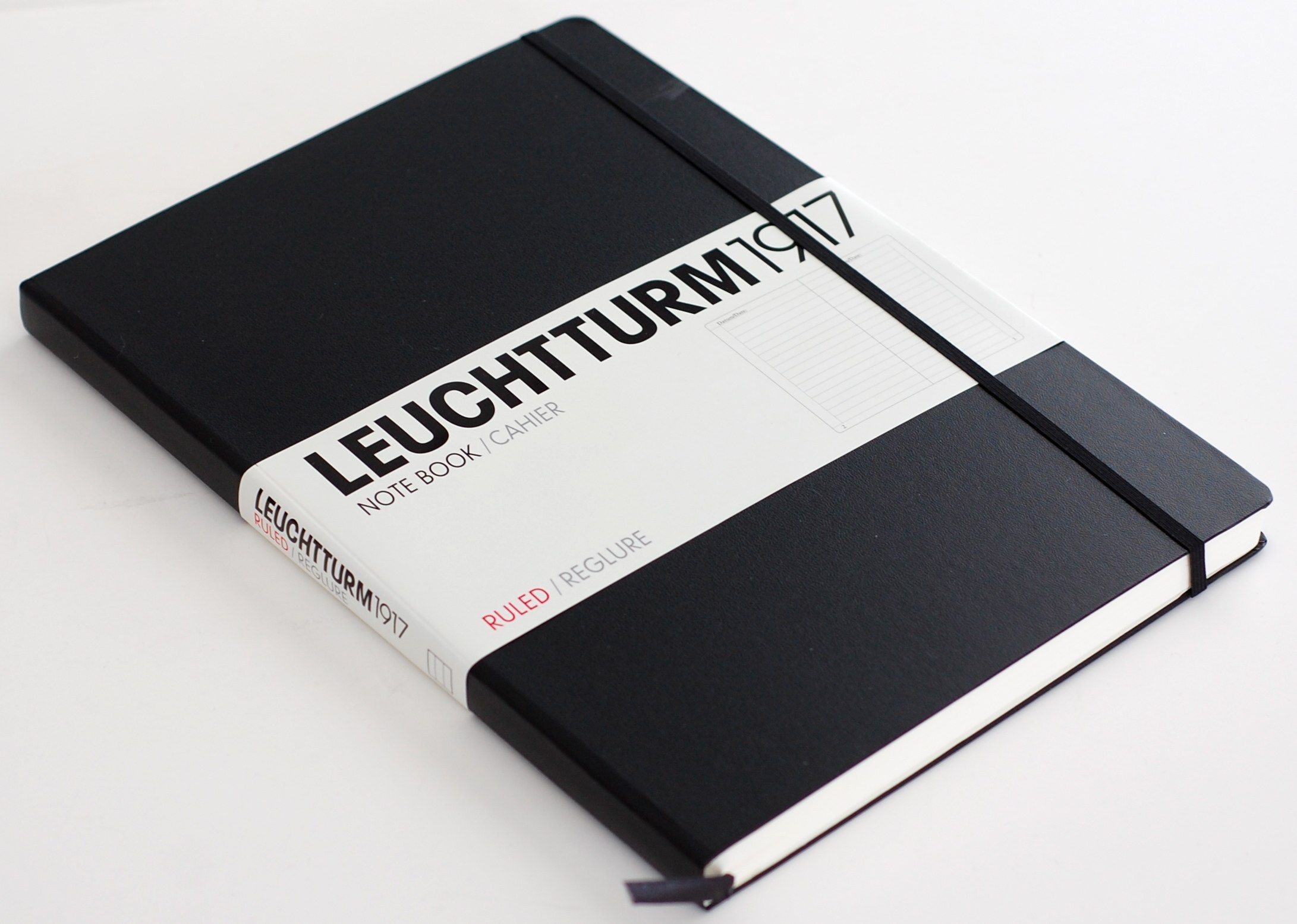
Paired with his favorite fountain pen, Joe Hill opts for Leuchtturm1917 notebooks. Source: J. Mark Bertrand
One would think Hill learned the importance of a good fountain pen from his father, Stephen King. However, he attributes his habit of handwriting novels to a suggestion from mentor Neil Gaiman. Hill enjoys the physical satisfaction of “seeing the ink on the page” and the effect it has on his writing mindset. The pen behind Heart-Shaped Box and Strange Weather is a Pilot Metropolitan, which he praises on his personal Tumblr account.
Fun FactIn 1989, Hill made an appearance in the film Creepshow, which was written by his father, Stephen King.
Pilot Metropolitan Fountain Pen

A black Pilot Metropolitan fountain pen. Source: pilotpen.us
Pilot Metropolitan pens are as easy on the eyes as they are on the wallet. Known for having nibs finer than a grain of sand, they lay down a consistent line every time. Pilot Metropolitans are constructed with a durable plastic material, making the pen the perfect workhorse for everyday use. With its exceptional performance and prudent price tag, the Pilot Metropolitan is the perfect instrument for the fountain pen beginner.
18. Christopher Paolini – LAMY and Pilot Décimo

Source: Niccolò Caranti, Christopher Paolini – Lucca Comics and Games 2012, CC BY-SA 3.0
Most 18-year-olds spend their time going to football games, playing Xbox, and stressing about life after graduating high school. For Christopher Paolini, however, being 18 meant touring the country to promote his first novel, Eragon, which he originally self-published. The youngest fountain pen scribe on our list is best known for writing The Inheritance Cycle, his tetralogy of young adult high fantasy novels which includes Eragon, Eldest, Brisingr, and Inheritance. In a stroke of fate reminiscent of only the best fantasy novels, one of the audience members in attendance at an Eragon tour stop was the son of famed crime fiction and children’s author Carl Hiaasen. After seeing how much his son appreciated the novel, Hiaasen recognized its potential and helped Paolini land a publishing deal with Alfred A. Knopf in 2003.
Even at 18 years old, Paolini recognized the value of returning to old-fashioned practices to create manuscripts in lieu of typing on a computer. The old soul not only prefers fountain pens for his writing, but considers himself an enthusiast. He writes first drafts of each of his books in longhand, an aesthetic practice that matches the fantasy settings of his novels. His passion for fountain pens extends to the web as well, where he reviews fountain pens and discusses his favorite brands with fans. Paolini tweeted about his preference for converter fountain pens in 2013, deeming them “much more convenient and economical.” He is a fan of pens made by both LAMY and Pilot.
Fun FactPaolini drew his own cover art for the first edition of Eragon.
LAMY Fountain Pens
A striking yellow model of the LAMY Safari fountain pen. Source: lamy.com
The LAMY Safari fountain pen is Paolini’s most trusted companion. In a YouTube video published in 2015, Paolini proclaimed his love for the pens, stating that he keeps “one blue and one black, one fine and one extra-fine” with him at all times. While Safaris are more nominal in cost, he also likes the slightly pricier LAMY AL-Star. LAMY pens come in a variety of hip colors, making them perfect for young aspiring authors like Paolini. Perhaps the secret to your authorial success is a LAMY fountain pen and a nationwide self-created book tour!
Pilot Décimo
With a retractable nib, the Pilot Décimo is ideal for an author on the go. Source: pilotpen.us
While “Décimo” may mean “tenth” in Italian, this instrument comes first on Paolini’s list. When Paolini is in the mood for a luxury pen, he reaches for his Pilot Décimo. The Décimo is similar to Pilot’s Vanishing Point, but has a smaller barrel–perfect for the fountain pen rookie. Capless versions of the pen sport the same clever hooded nib as the Vanishing Point. The nibs for this pen are another source of praise, as their clarity and fluency make writing feel like a fantasy. The nib’s source material could be straight from a dragon’s lair– some are even crafted out of 18k gold.
A Final Chapter
Without the invention of the fountain pen, we may never have sailed down the Mississippi with Huck Finn, felt the gravitas of the Holocaust through the words of Anne Frank, or solved thrilling mysteries alongside Sherlock Holmes. Whether these 18 paragon authors are using the pens to sign books or create their next literary masterpiece, they clearly appreciate the value of writing by hand. Now, it’s time to pick up your own fountain pen and journal. It just might make you the next great literary icon!
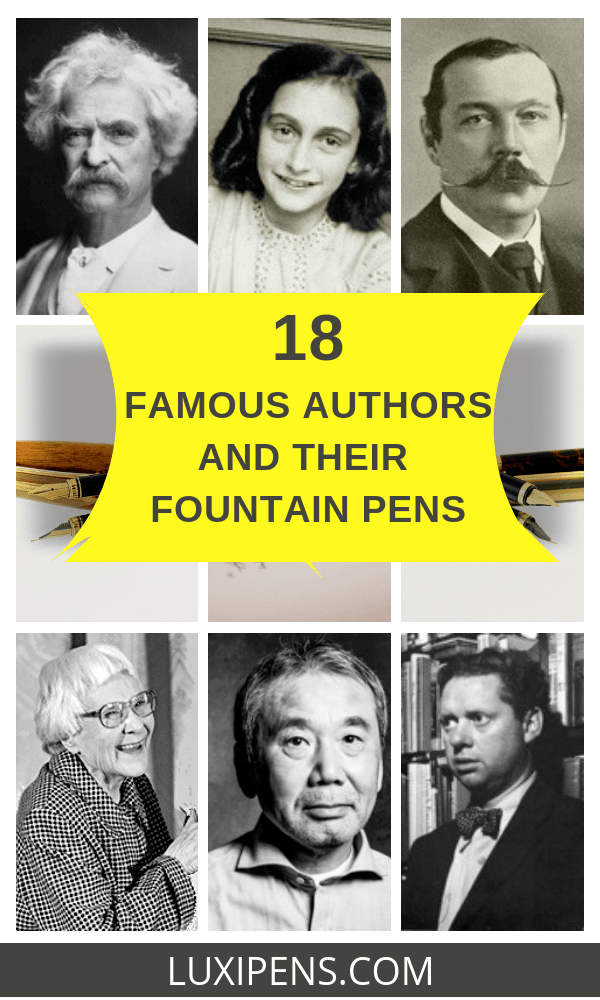
Sources
Apostolakou, Lito. “Haruki Murakami Mont Blanc and Pencils.” Palimpsest, 1 Aug. 2013, www.thepalimpsest.co.uk/2013/08/haruki-murakami-mont-blanc-and-pencils.html.
Bienias, Barbara. “Interview with Jonathan Carroll.” InteriorMad, 10 Jan. 2017, interiormad.com/interview-jonathan-carroll/.
Bishop, Katherine E. “Mark Twain’s Pens: ‘The Devil Will Be in It Tomorrow.’” Katherine E. Bishop, Ph.D., WordPress, 5 Sept. 2013, katherineebishop.wordpress.com/2012/12/28/mark-twains-pens/.
Brocklehurst, Steven. “Why Are Fountain Pen Sales Rising?” BBC News, BBC, 22 May 2012, www.bbc.com/news/magazine-18071830.
Campbell, Hayley. “Joe Hill Calls Bullshit On The Crazy Artist Cliché.” BuzzFeed, BuzzFeed, 11 Dec. 2015, www.buzzfeed.com/hayleycampbell/joe-hill-calls-bullshit?utm_term=.hb7YllMkV.
Campbell, Hayley. “This Is What A Handwritten Novel By Neil Gaiman Looks Like.” BuzzFeed, BuzzFeed, 24 Dec. 2015, www.buzzfeed.com/hayleycampbell/the-art-of-neil-gaiman?utm_term=.qjen11XPm.
Carroll, Jonathan. “‘Fountain Pens Are Cranky, Unforgiving…”.” Facebook, 4 Oct. 2012, www.facebook.com/thejonathancarroll/posts/10150291443944959.
Carroll, Ryder. “Jonathan Carroll.” Bullet Journal, 2 Dec. 2015, bulletjournal.com/jonathan-carroll/.
coffe_cup. “Who Use Which Fountain Pen? – Pen History.” The Fountain Pen Network, 14 Feb. 2008, www.fountainpennetwork.com/forum/topic/53523-who-use-which-fountain-pen/.
Copyright © RichardsPens.com, last edited 5 August 2018, and Copyright © RichardsPens.com, last edited 2 August 2018. “Richard Binder • Fountain Pens – Pens That Write Right!” RichardsPens.com • Pens That Write Right!, richardspens.com/?page=ref%2Fprofiles%2Fj.htm.
Elmo & Montegrappa S.p.a. “Limited Editions.” Montegrappa – Sito Ufficiale, www.montegrappa.com/en/collections/edizionilimitate.html.
Escalara, Arturo. “What Murakami and Other Literary Giants Learned From Brand Writing.” The Content Strategist, The Content Strategist, 20 June 2015, contently.com/strategist/2015/06/19/what-murakami-and-other-literary-giants-learned-from-brand-writing/.
Gaiman, Neil. “Fountain Pens. Always. Especially Pilot 823 for Signing and Lamy 2000 for Novels. RT @FMorrison42: Rollerball or Fountain?” Twitter, Twitter, 17 Dec. 2015, twitter.com/neilhimself/status/677320386053144576.
Gaiman, Neil. “Hi Neil, I Was Wondering If You Ever Still Use…” Neil Gaiman, Tumblr, 6 Mar. 2012, neil-gaiman.tumblr.com/post/18831584457/hi-neil-i-was-wondering-if-you-ever-still-use.
Gaiman, Neil. “On the Topic of Fountain Pens, Are There Any Lower…” Neil Gaiman, Tumblr, 18 Apr. 2012, neil-gaiman.tumblr.com/post/21329587979/on-the-topic-of-fountain-pens-are-there-any-lower.
Haden, David. “On Lovecraft’s Pen.” TENTACLII :: H.P. Lovecraft Blog, WordPress, 9 Aug. 2011, tentaclii.wordpress.com/2011/08/08/on-lovecrafts-pen/.
Hegarty, Stephanie. “Haruki Murakami: How a Japanese Writer Conquered the World.” BBC News, BBC, 17 Oct. 2011, www.bbc.com/news/magazine-15316678.
Hill, Joe. “Creature of Habit.” Joe Hill’s Thrills, Tumblr, 17 Nov. 2014, joehillsthrills.tumblr.com/post/102824432062/creature-of-habit.
Hill, Joe. “Have Also Field Tested Different Fountain Pens. This Inexpensive Pilot Is the Best so Far (Pictured w/Notebook): Pic.twitter.com/LPHEHdAyDN.” Twitter, Twitter, 29 June 2013, twitter.com/joe_hill/status/351009025237843970?lang=en.
Hill, Joe. “I’m Crazy over Pens so I’ve Gotta Ask – What Are…” Joe Hill’s Thrills, 15 Dec. 2014, joehillsthrills.tumblr.com/post/105275091812/im-crazy-over-pens-so-ive-gotta-ask-what-are.
https://www.abetterdesk.com/blog/2015/10/31/pilot-metropolitan-review
Joe Hill Fiction, 2018, www.joehillfiction.com/.
Joshi, S. T. “Howard Phillips Lovecraft: The Life of a Gentleman of Providence.” The H.P. Lovecraft Archive, 20 Mar. 2018, www.hplovecraft.com/life/biograph.aspx.
Jr, James D. Watts. “ARTS: Neil Gaiman on Getting Hooked on Handwriting.” Tulsa World, TulsaWorld.com, 10 Mar. 2015, www.tulsaworld.com/blogs/scene/arts/arts-neil-gaiman-on-getting-hooked-on-handwriting/article_d0198b7e-2476-548c-afc9-b0e11609bb1b.html.
Jr, James D. Watts. “ARTS: Neil Gaiman on Getting Hooked on Handwriting.” Tulsa World, TulsaWorld.com, 10 Mar. 2015, www.tulsaworld.com/blogs/scene/arts/arts-neil-gaiman-on-getting-hooked-on-handwriting/article_d0198b7e-2476-548c-afc9-b0e11609bb1b.html.
King, Stephen. “@Jack_LedfordIII Wore out Four Watermans Writing That Book.” Twitter, Twitter, 7 Jan. 2014, twitter.com/stephenking/status/420364741194694656.
Lahey, Jessica. “How Stephen King Teaches Writing.” The Atlantic, Atlantic Media Company, 9 Sept. 2014, www.theatlantic.com/education/archive/2014/09/how-stephen-king-teaches-writing/379870/.
Macaulay, Mike. “Christopher’s Pens and Paper and Ink-Oh My!” Paolini, 9 Aug. 2017, www.paolini.net/2015/08/25/pens-paper-ink/.
Morales, Daniel, and W. David Marx. “» Murakami Haruki’s Advertorial Short Stories:: Néojaponisme » Blog Archive.” Neojaponisme, 20 Nov. 2014, neojaponisme.com/2014/11/20/murakami-harukis-advertorial-short-stories/.
moviewatcheralaska. “Stephen King on Early Show 2001.” YouTube, YouTube, 3 Oct. 2007, www.youtube.com/watch?v=w0lofwQTWKk.
Murakami, Haruki. “The Running Novelist.” The New Yorker, The New Yorker, 19 June 2017, www.newyorker.com/magazine/2008/06/09/the-running-novelist.
O’Connell, John. “Neil Gaiman: How I Write.” Time Out London, 5 Oct. 2006, www.timeout.com/london/books/neil-gaiman-how-i-write.
Paolini, Christopher. “@b_e_scholz Good Old Lamy Safari. Have Two of Them, and I Just Picked up an Al-Star.” Twitter, Twitter, 14 Nov. 2015, twitter.com/paolini/status/665460107820605440.
Paolini, Christopher. “Fountain Pens Are Best for Writing Large Amounts by Hand — Less Friction between Nib and Paper. Plus, They Look Neat.” Twitter, Twitter, 19 Jan. 2012, twitter.com/paolini/status/160032181031415809.
Paolini, Christopher. “Just Bought Three New Fountain Pens (Already Have Two). Will Post Reviews Once They Arrive. Yes Fountain Pens Are Best If You Write a Lot.” Twitter, Twitter, 1 Apr. 2013, twitter.com/paolini/status/318782856379920384.
Paolini, Christopher. “My New Fountain Pen (a Pilot Decimo): Pic.twitter.com/lgYSe4vVOm.” Twitter, Twitter, 28 Apr. 2014, twitter.com/paolini/status/460619342049464320.
Paolini, Christopher. “Usually with Fountain Pens I Use a Converter, Which Lets Me Fill Them from a Bottle. Much More Convenient and Economical.” Twitter, Twitter, 13 Apr. 2013, twitter.com/paolini/status/323180444701048832.
Paolini. “Christopher Paolini: Pens and Paper and Ink-Oh My!” YouTube, YouTube, 1 Sept. 2015, www.youtube.com/watch?v=b_iMBInQx8w.
“Pen Review: Pilot Custom 823.” The Gentleman Stationer, www.gentlemanstationer.com/blog/2016/8/27/pen-review-pilot-custom-823.
Rosenberg, Liz. “CHILDREN’S BOOKS: The Egg and Him.” The New York Times, The New York Times, 16 Nov. 2003, www.nytimes.com/2003/11/16/books/children-s-books-the-egg-and-him.html.
Sailor Pens, www.sailorpen.com/.
Sheaffer Snorkel 1952-1959, penhero.com/PenGallery/Sheaffer/SheafferSnorkel.htm.
Slonim, Jeffrey. “A-Listers Talk About Their Favorite Pens.” Architectural Digest, Architectural Digest, 2 Sept. 2015, www.architecturaldigest.com/gallery/celebrities-favorite-pens-slideshow/all.
Telander, Alex C. “An Interview with Peter Straub (March, 2010).” Bookbanter, 15 Apr. 2010, bookbanter.wordpress.com/2010/04/15/an-interview-with-peter-straub-march-2010/.
TheHour. “Stephen King Talks To George Stroumboulopoulos.” YouTube, YouTube, 16 Sept. 2013, www.youtube.com/watch?v=QQ_S89fdg38.
Weiss, Josh, and Carol Pinchefsky. “WATCH: Black Mirror Producers Say Technology Isn’t the Enemy.” Syfy, SYFY WIRE, 12 Oct. 2017, www.syfy.com/syfywire/watch-black-mirror-producers-say-technology-isnt-the-enemy.
wolf4. “Serious Novel Writers – the Fountain Pen or PC? – Fountain & Dip Pens – First Stop.” The Fountain Pen Network, 15 Apr. 2010, www.fountainpennetwork.com/forum/topic/151314-serious-novel-writers-the-fountain-pen-or-pc/.
Zaleski, Jeff. “The Uses of Horror.” PublishersWeekly.com, 6 Oct. 2003, www.publishersweekly.com/pw/print/20031006/24502-the-uses-of-horror.html.
“Biography.” Mark Twain House, marktwainhouse.org/about/mark-twain/biography/.
“Dylan Thomas.” Wikipedia, Wikimedia Foundation, 14 Aug. 2018, en.wikipedia.org/wiki/Dylan_Thomas.
“Mark Twain.” Conklin – Conklin Mark Twain, www.conklinpens.com/mark_twain_page.html.
“Mark Twain Crescent Collection.” Conklin Pen Co., www.conklinpens.com/conklin_old/product/twain2.html.
“Mark Twain Limited Edition Demonstrator.” Conklin Pen Co., www.conklinpens.com/mark_twain_limited_edition_page.html.
“Mark Twain Signature Collection.” Conklin Pen Co., www.conklinpens.com/conklin_old/product/signature.html.
“r/Fountainpens – Which Celebrities Are Know FP Users?” Reddit, www.reddit.com/r/fountainpens/comments/601yq5/which_celebrities_are_know_fp_users/.
“Royal Society of Literature » History.” The Royal Society of Literature, rsliterature.org/about-us/history/.
“Sheaffer.” Wikipedia, Wikimedia Foundation, 6 Aug. 2018, en.wikipedia.org/wiki/Sheaffer.
“Simone De Beauvoir.” Wikipedia, Wikimedia Foundation, 15 Aug. 2018, en.wikipedia.org/wiki/Simone_de_Beauvoir.
“StephenKing.com.” StephenKing.com, 2018, www.stephenking.com/.
“Sylvia Plath.” Wikipedia, Wikimedia Foundation, 15 Aug. 2018, en.wikipedia.org/wiki/Sylvia_Plath.
“The Writing Tools of 20 Famous Authors.” Flavorwire, Flavorwire, 19 Aug. 2013, flavorwire.com/410384/the-writing-tools-of-20-famous-authors/view-all.

